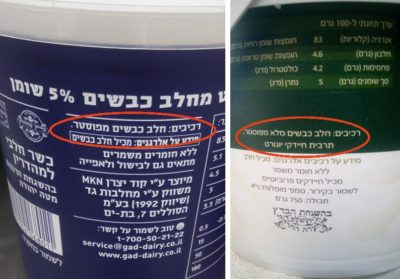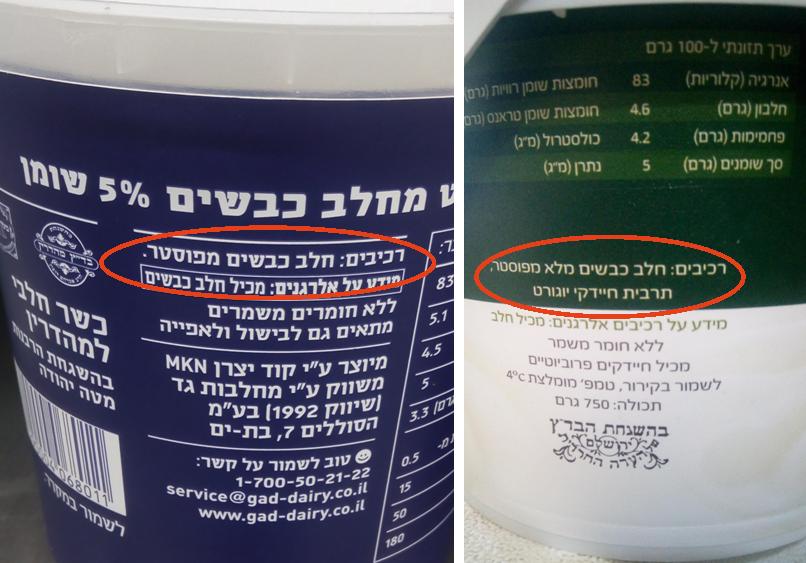Why Some Israeli Yogurts Aren’t Really Yogurt

There was a surprise in store for me when I scrutinized the yogurt (יוֹגוּרט – yogurt) container. What I discovered might surprise you, too.
In the United States in the late ’70s, Dannon yogurt featured commercials extolling the longevity of Soviet Georgians who ate plenty of yogurt. The takeaway, of course, was that if you eat yogurt you will be enhancing your longevity. These commercials helped to propel the growth of the yogurt industry in the USA.
https://www.youtube.com/watch?v=R9RJBgNB1ZI
Whether or not eating yogurt regularly is the main reason that these people were purported to live long and healthy lives, yogurt, a fermented food, is supposed to be rich in probiotics; probiotics are important components of healthy gut flora and critical for both physical and mental health. Several European countries include yogurt or beneficial microbes in their dietary guidelines. In fact “…”yoghurt” was defined in 1925 and specifies a typical milk fermented with Streptococcus thermophilus and Lactobacillus delbrueckii subsp. bulgaricus.”[1] Most people I know also associate it with probiotics and consume it with that intention or expectation.
When I went food shopping after we first made aliyah, I noticed that there was yogurt and there was bio (pronounced beeyo by Israelis) yogurt. I had never seen it labeled as “bio” in the States. Not considering that there might be a real difference between the two that would actually matter to me, I never checked it out. And while we preferred the goat and sheep yogurt sold in the Organic Market near us (which happened to be bio), since even yogurts sold in the health food stores are not necessarily organic, we also bought other plain, unflavored sheep yogurt (יוגורט כבשים – yogurt cvasim), goat yogurt (יוגורט עיזים – yogurt eezeem), and cow yogurt (generally just labeled as yogurt).
This all ended the other day, however. I was looking at the ingredients (רכיבים – richivim) on the container we had in the house and I realized, that aside from milk, there were no other ingredients listed. Having noticed on occasion the inclusion of probiotics in the ingredients of other brands, I called the company to inquire. And that’s how I learned that (at least in Israel) if it’s not bio yogurt and lists probiotics as an ingredient, it has no probiotics in it! In other words, if it doesn’t say “bio” on the label, then by definition, it is not yogurt.
While the websites of some commercial brands of bio yogurt sold in Israel don’t say which probiotics are contained in theirs, the website for Halav Haaretz, the brand that we usually buy in the health food (and other) stores, lists as their probiotics the two strains of bacteria, Streptococcus thermophilus and Lactobacillus delbrueckii subsp. Bulgaricus, which are included in the definition above.

I’m done with the fake yogurts – are you?
Notes:
[1] Probiotics in dietary guidelines and clinical recommendations outside the European Union
Related Articles:
Are Your Gut Microflora Doing the Happy Dance?
Resources:
Lactobacillus Bulgaricus and Streptococcus Thermophilus Yogurt Benefits
Did you find out how ot is made thicker than milk? Isn’t it the fermentation process that thickens it? You shouldn’t have to be adding the probiotics to it. I used to make my own yoghurt Nd just a spoon of yoghurt added to milk would make more yogurt. Maybe the amount is so small that they don’t have to list it. Maybe the bio has more added on top of what’s naturally there. No idea. Just asking….
Commercial yogurt is pasteurized which would serve to destroy most (all?) beneficial bacteria which is why they add them in. If the amount that remains is small then it’s not really doing anyone much, if any, good. Pasteurized milk is an almost – not quite – dead food. They may call it yogurt but it’s not what most of us think we are getting.
Thanks for the info Caryn. I didn’t know this, but have wondered about the different “yogurt” products. The goat yogurt I have on hand does have the probiotics in the ingredients, but also some “E” items. I will have to look more carefully at labels. This one I get at the regular supermarket, not the health food store.
So are any of the commercial ‘bio’ yogurts worth getting?
Worth getting in terms of adequate probiotics? Without lab testing it’s hard to know how much they each really contain, but certainly it is better to get the bio yogurt than the others.
What did the company actually say?
The company said that if probiotics aren’t listed in the ingredients it doesn’t have any. I was also told this by staff in one of the health food stores.
If the yogurt is pasteurized, its 100% certain that there are no living probiotics in the yogurt despite it saying otherwise. After pasteurization, sometimes they add additional probiotics but they aren’t the same as before the pasteurization process.
From what I understand, it is pasteurized and then starter culture is added to get the yogurty texture, but only allowed to ferment for about an hour. Yogurts made that way have no probiotics. The bio-yogurts then have probiotics added in. Of course this is in no way comparable to yogurt made from raw milk.
If you make your own yogurt with probiotics then you need to let it ferment for 24 hours.
While I have known about this for quite a few years, my family simply is unwilling to eat most of the probiotic yoghurts!
However, until your husband introduced me to your website, I hadn’t noticed that one of the pribiotic ingredients in the healthy true yoghurts is “Streptococcus thermophilus”!
Isn’t that a bacteria associated with strep throat? Maybe you could post an article explaining how it is healthy in this context?
Bivrachah,
Catriel Lev, Ramat Bet Shemesh Alef
Hi Catriel, That’s a great question. Streptococcus is a family of bacteria having similar characteristics but some are pathogenic and some are not. Same with E. Coli and I’m sure other types of bacteria.
This is what Wikipedia (https://en.wikipedia.org/wiki/Streptococcus) has to say about Streptococcus:
Streptococcus is a genus of coccus (spherical) Gram-positive bacteria belonging to the phylum Firmicutes[3] and the order Lactobacillales (lactic acid bacteria). Cell division in this genus occurs along a single axis in these bacteria, thus they grow in chains or pairs, hence the name—from Greek στρεπτός streptos, meaning easily bent or twisted, like a chain (twisted chain). (Contrast this with staphylococci, which divide along multiple axes and generate grape-like clusters of cells.)
…
In addition to streptococcal pharyngitis (strep throat), certain Streptococcus species are responsible for many cases of pink eye,[6] meningitis, bacterial pneumonia, endocarditis, erysipelas, and necrotizing fasciitis (the ‘flesh-eating’ bacterial infections). However, many streptococcal species are not pathogenic, and form part of the commensal human microbiota of the mouth, skin, intestine, and upper respiratory tract. Furthermore, streptococci are a necessary ingredient in producing Emmentaler (“Swiss”) cheese.
Streptococcus thermophilus (https://en.wikipedia.org/wiki/Streptococcus_thermophilus):
It is also classified as a lactic acid bacterium.[6] S. thermophilus is found in fermented milk products, and is generally used in the production of yogurt,[7] alongside Lactobacillus delbrueckii subsp. bulgaricus. The two species are synergistic, and S. thermophilus probably provides L. d. bulgaricus with folic acid and formic acid which it uses for purine synthesis.[8]
…
S. thermophilus is one of the most widely used bacteria in the dairy industry. USDA statistics from 1998 showed that more than 1.02 billion kilograms of mozzarella cheese and 621 million kilograms of yogurt were produced from S. thermophilus.[10] Although its genus, Streptococcus, includes some pathogenic species, food industries consider S. thermophilus a safer bacterium than many other Streptococcus species. In fact, yogurt and cheese that contain live cultures of S. thermophilus are thought to be beneficial to health.[11] Live cultures of S. thermophilus make it easier for people who are lactose intolerant to digest dairy products. The bacteria break down lactose, the sugar in milk, that lactose-intolerant people find difficult to digest.
*Hi,
I’m a bit confused by the Halav Haaretz line of yogurts. Do they contain real, live probiotics? I buy the blue goat milk one to make my own yogurt with raw milk.
Thank you for taking the time to write your blog!! I truly apprciate it as I do my best to feed my family real food.
Hi Rachel,
Thanks for your kind words. We buy the Halav Haaretz as well. It does have the probiotics. Besides listing it in the ingredients on the back of the container, their website list the specific ones they use.
Hello, I find this very interesting.
I come from a country where you can easily find big bottles of high protein iogurt such as skyir in the super market. Here I only find the go brand of iogurts. And they don’t mention how they produce it in the product.
I do not know. There are several different brands of bio yogurts in Israel. I am not familiar with skyir and what the difference is between that one and regular bio yogurts
The question of how the non bio yogurts are thickened asked earlier was not addressed. Any idea?